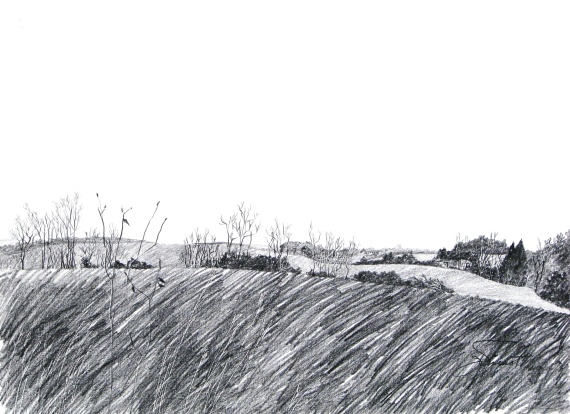

In February, 2013, I will be offering a “Back to the Basics” Drawing Course at the Bayou Arts Center, in Santa Rosa Beach, FL, for the Cultural Arts Alliance. The course will be four two-hour classes, on Tuesdays from 1:00 to 3:00pm. We will practice line quality, “seeing” shape and drawing what we see, and creating textures. We will practice drawing as preliminary to other art, as well as drawing as the final masterpiece, and we will experiment with several kinds of media.
An otherwise fabulous work of art can be ruined by poor perspective. So in the first of the four two-hour classes, we will review one-point and two-point perspective, which are useful tools for making representational objects look “right” in our attempt to create the illusion of 3 dimensions on a two-dimensional surface. Knowledge of perspective will assist us in seeing correctly.
Above is a drawing I made several years ago, showing the weeds near to the viewer to be much larger, relative to the trees and the structures further back in the picture plane. As objects recede, they should be drawn smaller and there is an orderly way to go about that, which is the tool called perspective.
Below I have posted a simple sketch showing some perspective problems. You immediately get a sense that there’s something wrong with this picture, and you may or may not notice what it is exactly that bothers you, but you will recognize it and agree that the house on the right looks crooked, and the telephone poles seem too tall as they go over the horizon, and the fence underneath them doesn’t seem right, and the tractor looks too small.
Back-to-the Basics Drawing Course
Register at (850) 622-5970. The fee is $100 for CAA members, slightly more for non-members. Below is the suggested supply list.
- Ebony pencils — jet black, extra smooth (Prismacolor) or similar very soft, black graphite pencil (6B or 8B)
- A water-soluble pen, dark (Vis-a-Vis, or Flair) — blue, black, or brown
- A white eraser (White Pearl)
- 12″ ruler — 18″ is even better
- Watercolor brushes — nothing fancy, anything will do, but if you have one, a #4 rigger/liner/script and #6 pointed round
- Small water container (Dixie cup is fine)
- Soft cotton rag for smudging
- Old sketchbook for note-sketches and for practicing at home
- Assortment of papers — white, cream, mid-tone, and colors, different textures, nothing terribly expensive, but better than newsprint,whatever you have on hand, and perhaps some watercolor paper or illustration board, 12 x 18 or larger
- Plus anything else you might want to draw with or on
- You may want a to bring your drawing board and table easel or stand-up easel, but we can work on the tabletops.
- Optional supplies the instructor will bring for you to experiment with:
- Charcoal pencil, paper-wrapped — soft or extra soft (Berol)
- Woodless pencil, 6B (Grafstone), or graphite sticks
- Cretacolor Woodless watercolor pencils (Aqua Monolith)
- Nupastel, white, and some dark colors
- Stabilo Aquarelle Black 8046 or Red 8040 or Brown 8045
- Practice paper (cheap, not colorfast): Smooth newsprint, Textured newsprint, Gray bogus paper
A water-soluble pencil, i.e., Derwent Sketching pencil – dark wash, 8B, or Derwent Graphtint pencil – nice colors are steel blue(06), port (01), shadow blue (05)
The instructor gets supplies from www.dickblick.com, and standard delivery is usually about 10 days. But please do not spend a fortune — let’s use the supplies you already have!

